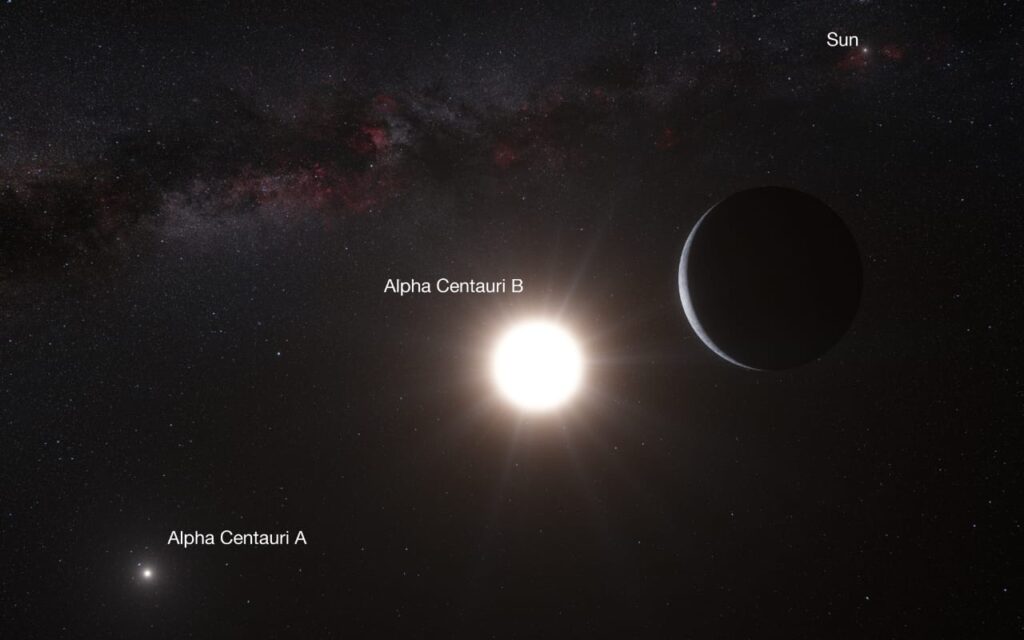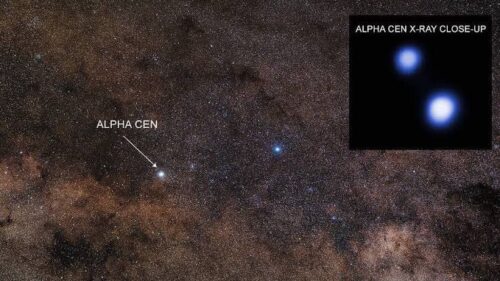The search for extraterrestrial life has captivated humanity’s imagination for centuries. Among the countless celestial bodies in the universe, Alpha Centauri, our nearest neighboring star system, holds particular intrigue.
In this article, we delve into the fascinating endeavor of hunting for life in Alpha Centauri, exploring the current knowledge, ongoing missions, and the potential implications of discovering life beyond Earth.

Alpha Centauri: A Neighboring Star System
Alpha Centauri, located a mere 4.37 light-years away from our solar system, is a trio of stars consisting of three main components: Alpha Centauri A, Alpha Centauri B, and Proxima Centauri.
The latter, Proxima Centauri, has garnered significant attention due to its proximity and the potential for habitable environments. Exploring Alpha Centauri offers a unique opportunity to study our cosmic neighbors and deepen our understanding of the universe.
Proxima Centauri: The Promising Red Dwarf
Proxima Centauri, a red dwarf star within the Alpha Centauri system, holds great promise in the search for habitable environments and potential life. As the closest known star to our solar system, Proxima Centauri has attracted significant attention from scientists and astronomers.
Its smaller size and cooler temperature make it more likely to host rocky exoplanets within its habitable zone. These planets may have conditions conducive to liquid water and, consequently, the potential for supporting life. Proxima Centauri offers a compelling target for future exploration and the exciting possibility of discovering extraterrestrial life in our cosmic neighborhood.
The Transiting Exoplanet Survey Satellite (TESS)
The Transiting Exoplanet Survey Satellite (TESS) is a NASA mission designed to discover exoplanets orbiting stars outside our solar system. Launched in 2018, TESS employs the transit method to detect exoplanets by observing the slight dimming of a star’s brightness when a planet passes in front of it.

TESS surveys a vast area of the sky, divided into 26 sectors, and observes each sector for about a month to capture potential transit events. By monitoring a wide range of stars, including those within the Alpha Centauri system, TESS helps identify exoplanet candidates for further investigation.
One of TESS’s primary objectives is to find Earth-sized planets within the habitable zones of their host stars. These planets may have the right conditions to support liquid water, making them potential candidates for hosting life as we know it.
The data collected by TESS is invaluable for the scientific community. It provides valuable insights into the demographics of exoplanets and helps researchers refine their understanding of planetary formation and evolution. TESS is a crucial stepping stone in our ongoing quest to find habitable worlds beyond our own and expand our knowledge of the universe’s diversity.
The Starshot Initiative: Pushing the Boundaries of Exploration
Breakthrough Starshot, a project within the Breakthrough Initiatives program, envisions a revolutionary approach to exploring Alpha Centauri. Leveraging advanced technology, including laser-propelled light sails, miniature spacecraft could be dispatched to the star system in a matter of decades. These interstellar probes would provide an up-close examination of potential habitable planets and any signs of life.
The Search for Biosignatures: Indicators of Life
Scientists employ various methods to detect potential signs of life, known as biosignatures. These include the analysis of exoplanet atmospheres for gases like oxygen, methane, and water vapor, which could suggest the presence of living organisms. Upcoming telescopes, such as the James Webb Space Telescope (JWST), are poised to significantly enhance our ability to scrutinize exoplanet atmospheres and potentially detect biosignatures.
The Impact of Discovering Life in Alpha Centauri
The discovery of life in Alpha Centauri would have profound implications for our understanding of the universe and our place within it. Here are some potential impacts:
1. Confirmation of Life Beyond Earth: Finding life in Alpha Centauri would provide compelling evidence that life exists beyond our planet. It would confirm that Earth is not the only habitable world in the vast cosmos, raising questions about the prevalence and diversity of life in the universe.
2. Redefining the Habitability Zone: Discovering life in Alpha Centauri could expand our understanding of the conditions necessary for life to thrive. It would refine our definition of the habitable zone around stars and shed light on the range of environments where life can potentially exist.
3. Insights into Extraterrestrial Life: Studying alien life forms in Alpha Centauri could offer invaluable insights into the origins, evolution, and biology of organisms that developed independently from Earth. Understanding different forms of life could challenge our preconceived notions and expand our knowledge of the possibilities of life in the universe.
4. Philosophical and Cultural Impact: The discovery of extraterrestrial life in our cosmic neighborhood would have profound philosophical and cultural implications. It would spark existential questions about our place in the universe, our uniqueness, and our connections to other intelligent beings. It could also promote global unity as humanity collectively grapples with the profound implications of such a discovery.
5. Technological Advancements: The quest for life in Alpha Centauri would drive technological advancements and innovations. The development of more powerful telescopes, spacecraft, and instruments would be necessary to study and explore the newfound life forms. These technological advancements could have broader applications in various scientific and technological fields, benefitting society as a whole.
6. Inspiration for Future Exploration: The discovery of life in Alpha Centauri would ignite a renewed passion for space exploration. It would inspire future generations of scientists, astronomers, and explorers to delve deeper into the cosmos, sparking a new era of space exploration and discoveries.
Conclusion:
The pursuit of life in Alpha Centauri represents a bold and awe-inspiring quest that pushes the boundaries of human knowledge. With advancing technology, dedicated space missions, and innovative initiatives, we are inching closer to unraveling the mysteries of our cosmic neighborhood.
As our understanding deepens and our tools become more sophisticated, the possibility of discovering life, even microbial, in Alpha Centauri becomes increasingly tangible. In the face of this extraordinary endeavor, let us embrace the spirit of exploration and remain ever curious about the vast wonders that lie beyond our home planet.
